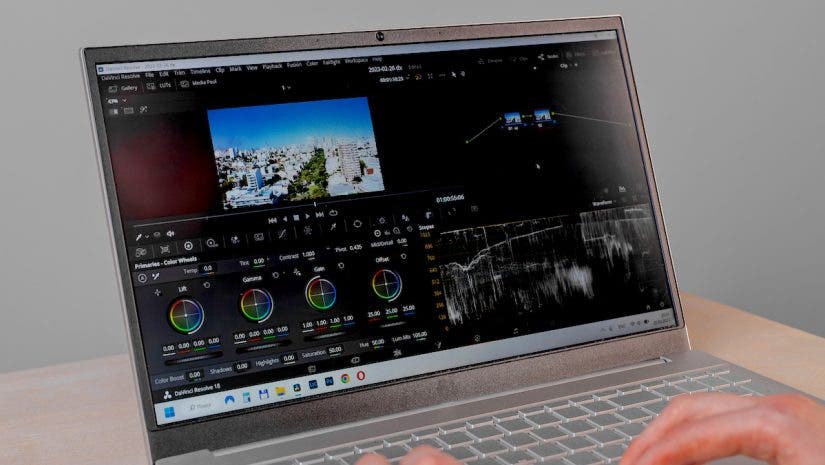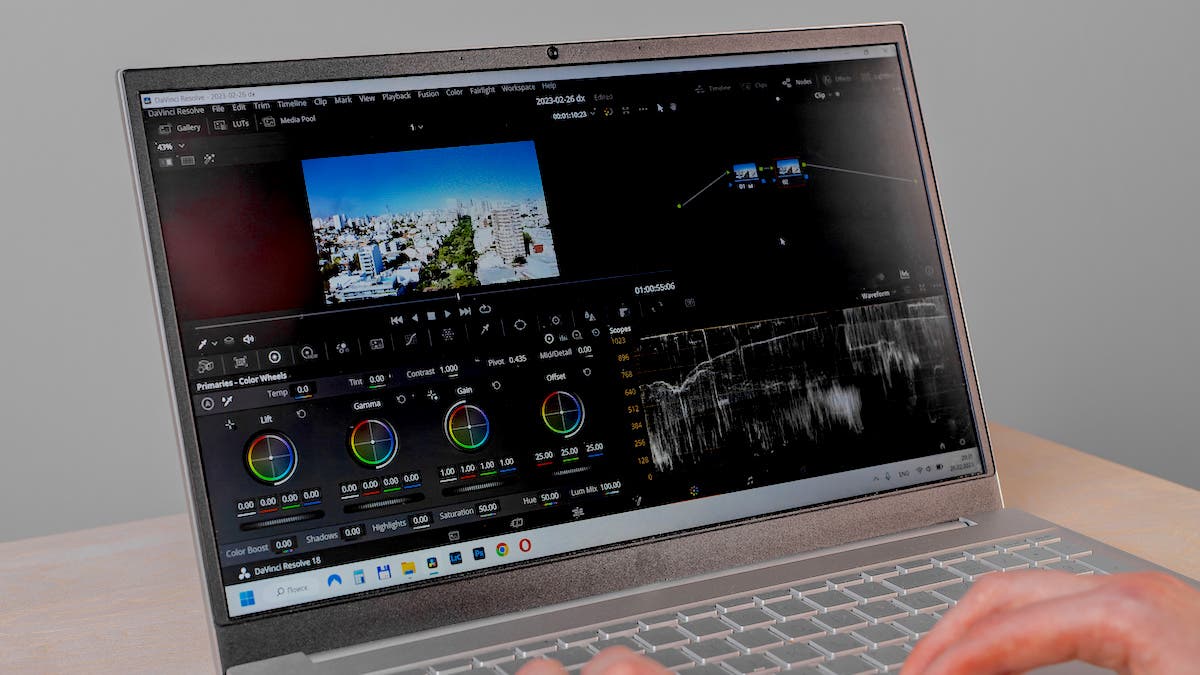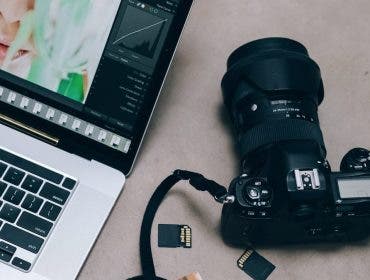Looking for video editing software approved by Hollywood professionals but affordable and easy to use? DaVinci Resolve is the video editor that helps you create a post-processing studio in your home or office. And it works equally well for editing blockbusters, individual films, short movies, music videos, video tutorials, and more.
The only thing you need to do is decide between two offerings: the DaVinci Resolve Free or Studio version. Here is everything you need to know to make the decision that will improve your work, open the door to professional video editing, and match your creative workflow.
What is DaVinci Resolve?
DaVinci Resolve is a video editing app produced by Blackmagic Design that includes tools for cutting and arranging video footage, applying color corrections, overlaying visual effects and motion graphics, and editing audio footage.
In short, it takes care of the entire post-processing stage and transforms raw footage into a ready-to-be-seen movie. DaVinci Resolve offers tools used by colorists, VFX artists, editors, and sound engineers in a single place, freeing you from switching from one app to another.
In addition, the program allows real-time local and remote collaboration. For example, if one person does the video editing and another does the audio post-processing, they can collaborate and work simultaneously on the same project. The projects are safely hosted in the Blackmagic Cloud. Also, the program provides features for managing media and ensuring the editor has access to all the recordings.
The program receives regular updates and becomes better, faster, and more comfortable to use with each. The new 18.5 version includes four new AI-based tools, can classify audio clips automatically, and features the new Relight FX, which adds virtual lighting to a scene.
DaVinci Resolve requires a fairly new Windows, macOS, or Linux system. It also requires a good amount of system memory (8GB on macOS, 16GB on Windows, and 32GB on Linux), Blackmagic Design Desktop Video 10.4.1 or later, and at least 2 GB of VRAM. However, none of this is something unachievable for a video editor — amateur or professional.

DaVinci Resolve Studio vs. Free
Blackmagic Design offers a free version of DaVinci Resolve, which includes many of the basic tools for video and audio editing. One can very well manage with the free version for a while. Furthermore, you can use the free version to learn how to edit in DaVinci Resolve so that you make the most out of the paid version.
However, professional video editors and post-processing studios will want the paid version of DaVinci Resolve. Here are ten categories in which DaVinci Resolve Studio is superior to the free version.
1. Frame Rate and Resolution
The free version of DaVinci Resolve allows for an astonishing 60 fps at resolutions as high as Ultra HD 3840 x 2160. Meanwhile, DaVinci Resolve Studio takes the next step and offers 120 fps at resolutions as high as 32K. So if you are happy with 4K movies, the free version suits you perfectly. But if you want more than that—considering that some cameras offer 8K video recording—than you need the paid version.
2. GPU Acceleration
The free version features GPU (Graphics Processing Unit) acceleration to speed up the playback of high-resolution videos, but it supports just one GPU. The Studio version supports multiple GPUs, providing better performance to Metal (macOS) and OpenCL and CUDA (Windows and Linux) users.
3. Noise Reduction for Video
Cleaning the video footage of digital noise is a basic edit: the free version of DaVinci Resolve couldn’t be without a tool or two to clean up noise. However, the tools it provides are manual or require the use of a plugin. With DaVinci Resolve Studio, you get the most sophisticated built-in tools for noise reduction, such as the temporal and spatial noise reduction tools. The temporal noise reduction tool decides between noise and detail by looking at frames, while the spatial noise looks at neighboring pixels.
4. Lens Correction
If you need lens correction features, you need the Studio version. This is not offered in the free version. With the Studio, you’ll be able to correct spherical lens distortion or other aberrations thanks to powerful image analysis algorithms. Ultra-wide angle lenses are predisposed to lens distortions, so consider this aspect if you use an action camera or anything with a very wide lens.
5. DaVinci Neural Engine
DaVinci Neural Engine is a DaVinci Resolve Studio exclusive feature. It’s a set of deep neural networks and machine learning algorithms that perform automatic functions, such as facial recognition for organizing media based on the people in the shots, high-quality image upscaling (including re-linking and re-transcoding) for creating 4K and 8K images from HD sources, speed warp retiming, high-quality de-interlacing, smart masks for object isolation and tracking, smart reframing, removing objects, and many more.
DaVinci Neural Engine ensures you get high-quality videos without wasting time on repetitive tasks. You gain speed, precision, and efficiency. It’s a feature you need if you edit videos regularly.
6. Format Support
The free version of DaVinci Resolve supports 8-bit formats. The Studio version supports all these plus professional 10-bit formats. In addition, it supports advanced AVCHD, AVC-Intra, and popular H.264 camera formats, IMF encoding and decoding, advanced HDR delivery in Dolby Vision and HDR10+ formats.

7. Coloring
Most color grading tools are available in the free version of DaVinci Resolve because they are the program’s most popular features. But the Studio includes additional features that help you perfect your projects. For example, the paid version offers HDR Scopes for detailed information about ST.2084 and HLG images, tools for editing and grading stereoscopic 3D projects, remote grading that lets colorists and clients work together remotely, and not just LUTs but also color transformation scripts that make the most out of GPU acceleration.
8. 3D Audio
Like with color grading tools, most audio editing tools are present in the free version, too. But if you need immersive audio formats, high-resolution 3D audio, and other more advanced audio editing tools, you need to go for the Studio version. The paid version features import and export of the latest IAB and ADM files, support for object-based formats, native Dolby Atmos and MPEG-H import and rendering, and support for Auro-3D and SMPTE ST.2098.
9. Resolve FX
Resolve FX refers to the app’s collection of visual effects. While you’ll find the basic ones in the free version, too, the most advanced and smart ones are reserved for DaVinci Resolve Studio. The Studio features 30 additional effects, GPU and CPU accelerated, that cover lens flares and reflections, sharpening, retouching face and beauty, dirt removal, dust busting, de-flickering, adding film grain, patch replacing, and object removing. Resolve FX look and feel amazing.
10. Workflow Integration Plugins
If you need to connect to third-party software, such as digital asset management and automation systems, the Studio has you covered. It supports workflow integration plugins and even allows you to write plugins and interact with DaVinci Resolve’s JavaScript APIs. The Studio supports Python and LUA scripting and lets you create custom workflows.
In addition, Blackmagic Design offers dedicated hardware that complements the program and smoothes the workflow. With the right editor keyboard, color panel, and Fairlight audio console, video and audio post-processing becomes second nature.
DaVinci Resolve: Frequently Asked Questions
DaVinci Resolve is complex software that includes editing, color corrections, effects, and audio post-processing. It isn’t easy to learn everything at the same time. However, the program’s interface is thoughtfully designed. Each category of functionalities has its page, which means you get a dedicated workflow for a particular task. So you can learn the tools from each page at a time and move on from basic projects to complicated ones.
DaVinci Resolve Studio costs $295 and comes with a lifetime license. You can also receive an activation key for free when purchasing a Blackmagic Pocket Cinema Camera or the Blackmagic Design Speed Editor.
No, the free version of DaVinci Resolve doesn’t add a watermark. However, if you disregard the warning message and use one of the effects, Resolve FX or Fairlight FX, available only to Studio’s paying customers, you will get a watermark. But there is no way for the program to leave a watermark without warning you about it.
Yes, you need a powerful computer to use any video and audio editing software. The better the computer, the faster and more accurate your workflow is. The good news is DaVinci Resolve runs on Windows, Linux, and macOS systems and includes many features for optimizing your hardware resources and improving its performance. But you will need a rather new OS system version, a last-generation processor, and 8GB of RAM if you are using macOS, 16GB of RAM if you are using Windows, or 32GB of RAM if you are using Linux. You will also need a good monitor for color accuracy.
Conclusion
DaVinci Resolve aims to solve all your video and audio post-processing requirements and is one of the preferred editing software of professionals. While there are significant differences between the free and the paid versions, it is worth taking the time to analyze what you need, your editing skills, and your artistic purpose before purchasing the complete Studio. Familiarize yourself with DaVinci Resolve using the free version, see if it works well with your existing hardware, and if it fits your workflow. Move on to the advanced version when you need to take the next step toward professional video and audio editing.






